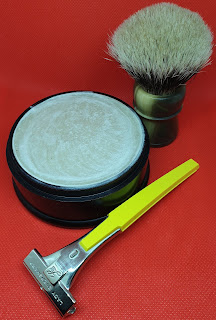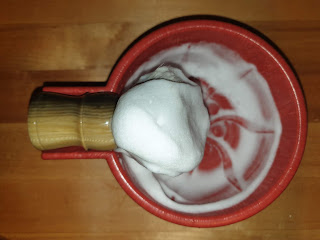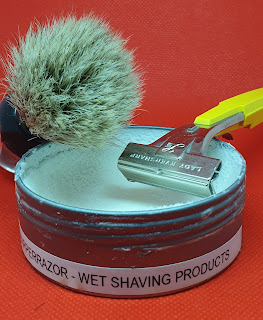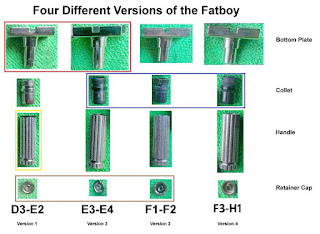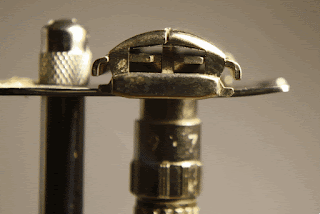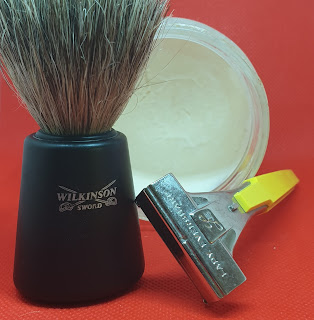Razor: Schick “Lady Eversharp”
Blade: Proraso Injector
Brush: Artesania Romera Manchurian Badger, imitation horn
Lather: Asylum Shave Works Colonia
Aftershave: BullDog Sensitive Aftershave Balm
Additional Care: Alum Block, BullDog Original Beard Oil, & Pereira Shavery Boomerang Beard Comb
Monthly Archives: July 2019
Self-sharpening safety razor
One of the reasons why the classic safety razor have seen a resurgence the later years is that you can get great blades for a fraction of the cost of a cart… but that was not always the case. As I’ve shown in previous posts*, when adjusted for inflation the blades used to be as costly as cartridges are today. With that in mind, the popularity of razor blade sharpeners** made a lot more sense… but it still required you to take the blade out of the razor. Wouldn’t it be easier if the blade could stay in the razor?
While not a new idea^, William R Ewing and Benton M Ewing filed a couple of interesting patents in 1948 and 1950 for a self-sharpening razor and improvements for it.
The two Ewings certainly aimed high with their invention, wanting to
…eliminate the need for constant replacement of blades in a device of the safety razor type by providing means whereby opposite faces of the blade edge may be sharpened at will…
The patent drawings shows a permanently attached single edge blade, and a sharpening element in the form of a roller.
Two interesting things that stands out on the sharpening roller is that the actual grinder is a arranged in a spiral shape around most of the circumference, and that the roller is shaped to act as the safety bar when in the neutral position. A lot of effort went into making sure that the blade was pushed evenly against the grinder, as evidenced by the flat spring pressing on the swingable blade holder. And it seems like it was that spring that was the major improvement in their second patent.
The vaguely kidney shaped cavity in the roller allowed the blade to swing enough to allow the roller to sharpen the upper side of the blade as well as the underside… how this works is best seen with the small illustration in the bottom left corner of the last drawing in conjunction with the illustration in the same location on the first drawing.
So after loosing the roller the shaver would push it along a flat surface, first one way and then the other, until the blade was sharp. Simple, easy, and fast… in one handy, complicated package.
Overall, the two patents shows a lot of ingenuity and effort going into perfecting a solution to a problem the shaver today simply don’t have… blades are so cheap these days we can change them daily if we want to.
*) See, for example, this post
**) Some of which is discussed in this post
^) The Shake Sharp dates from ’43
Shave of the day 29th July
Razor: Schick “Lady Eversharp”
Blade: Proraso Injector
Brush: Vie-Long #12705B
Lather: Proraso Menthol & Eucalyptus
Aftershave: Krampert’s Finest 80 Below
Additional Care: Alum Block, Gentlemen of Sweden Original Beard Oil, & Pereira Shavery Boomerang Beard Comb
Too hot to shave…
As you probably are aware, there is a heatwave in Europe these days… so I find it’s simply too hot to shave. 28°C in the shave den this morning, which don’t make it too inviting to stay in there for any amount of time.
On the bright side, the forecast is stating that the temperature should go down next week.
Everything old is new again, again
…and again, and again.
Heated razors is an age old quest. Gillette just dropped one, which seems to have impressed Mark over on the Sharpologist, and in their typical over the top marketing Gillette seems to be pushing this since the best shave ever… A hint for P&G: if you need to advertise the fact that your razor is waterproof, you’ve likely made an overly complicated razor.
Electrically heated razors isn’t a new idea by far, even if the latest itteration seems both more complicated* and far safer to use than some of the older ideas**.
While I can’t be completly sure, I’m reasonable satisfied that the current offering is based on a patent I found that was filed in in 2008 and assigned to the Gillette company – the patents describe a great many of the same features as the ads do.
…safety razor comprises a handle 14, a cartridge 15 with a safety device 18, a plate 24 and blades 30 between them. Inside the cartridge there is a heat-dispersive strip 40 and a heating element 45 with a resistive element 46 and an insulating element 50. The safety device comprises an electrical circuit providing power supply to the resistive element that provides heat to the heat-dispersive strip so that it imposes warmth to skin of the user during shaving.
The patent also lists twenty seven (27!) citations that predates it… and I found quite a few patents for heated razors that isn’t listed in the application.
Barra Charles filed a version all the way back in 1923. If you think the plug looks kind of odd it’s because you’re meant to screw it into a light bulb socket… so no chance of grounding it.
…electrically heat safety razors in such a manner that they may be conveniently used while being heated and that the heat may be maintained during the shaving operation at any desired temperature, whereby I am enabled to obtain the advantageous results of smoothness and comfort during shaving and to avoid infections of the skin which frequently occur from the use of unsterilised razors.
Charles Barra also filed a heated straight razor in 1923, or rather an attachment that turned your straight into a heated razor:
A razor blade heated to such a temperature will make shaving of a persons face more comfortable and the resulting shave will be more satisfactory than where the face is shaved with a cold razor.
…using an electric heater disposed at a suitable distance from the cutting edge of the blade, and in thermal relation thereto, which heater may be supplied with current from an ordinary electric service outlet, whereby the blade may be heated to and maintained at a sterilisation temperature both while not in use and while in the act of shaving.
(As a side note, sterilisation temperature is about 80°C (175°F) for almost all bacteria, yeast, and fungi… 80°C is enough to cause second and third degree burns in less than one second.)
In 1933 Pirwitz Emil filed for a safer variation, which required plugging and unplugging the razor:
…the invention employs a heating bolt disposed in the handle of the razor and made of material that is a good heat conductor, such as metal, the bolt iilling the entire handle from one end to the other and being adapted after one heating to keep the razor heated during an entire shaving operation without a new supply of heat.
…a bolt of this type permits the use of the razor without the dangers resulting from keeping the razor under current during the shaving operation.
Mr Pirwitz also showed an interesting variation in the same patent:
Look at figures 3 and 4; it’s a regular safety razor inserted into the heating device… which I presume you could either use while inserted in the bulky heater or take out and burn your fingers badly while shaving.
Thomas J Henderson and Leon Henderson aimed for cool hands in their 1935 patent:
The primary object of our invention is to provide in a safety razor a handle thereof which in use will apply heat only to the desired portion of the razor, that is, the head and blade, but will maintain a cool handle or grip.
A further object of our invention is to provide an electrically heated safety razor handle which is readily adapted for use on any suitable razor head.
Or how about this one from 1942, patented by Moses M Gravin?
…a safety razor with an electrically heated heating element therein which transmits an even heat to the razor blade and keeps it warm or hot during the shaving operation.
One of the objects of my invention is to heat the razor blade by conduction through a metallic element. I Another object of my invention is to provide ventilation between the heating element and the handle so that the handle will be cooled by the circulation of air.
In 1948 James Russel Hunt filed for a heated razor that allowed the shaver to adjust the current going into the razor by means of a rheostat:
..an electro-thermic shaver of the safety razor type which is adapted to directly heat the razor blade by heat conduction through a metallic element having a high coefficient of thermal conductivity such as copper.
…a heat control unit to permit the heat to be regulated by the user to produce various heat temperatures.
So as can be seen, the desire to make a heated razor is almost as old as Gillettes original safety razor… there is nothing new under the sun, nor in the shave den – except this time the offering isn’t that much bulkier than a regular razor, nor does it offer the exciting chance of electrocuting yourself while shaving.
*) It has overheat protection, two levels of heating, onboard battery with wireless charging, microcontroller, wobbly blades… I suspect the lats bit is unintentional
**) Hook your ungrounded razor up to the light fixture in your bathroom.. what can go wrong?
Shave of the day 24th July
Gillette Adjustable resource site
A number of my fellow wetshavers are extremely knowledgeable and enjoys sharing their labours of love. One of them is Glenn Conti, who knows more about Gillette adjustable razors than most shavers and collectors.
Glenn have put together a website detailing not only the details of how an adjustable razor work, not just pretty pictures of adjustable razors, not just how the Gillette adjustables evolved, but all that and much more. For example; I was clueless to the fact that including all variations there is about 150 distinct Gillette Adjustables out there, but Glenn have given more than enough detail to identify each one.
Glenn’s website is an invaluable resource for shavers and collectors alike, and I found it hard to close the window and go back to doing other things – the miscellaneous section in particular held my interest. The whole site is not only well written, but also well illustrated. A couple of examples:
Variations on parts used in the Fatboy razor. Some of the changes seems to have to do with function, some of them seems to be made for easier manufacture.
If you ever wondered how the gap changes on an adjustable, wonder no more. Glenn also details what the gap should be on each and every major variation of the Gillette Adjustables (apperantly my Slim is slightly milder than average).
So if you have a Gillette Adjustable, plan to get one, or just enjoys reading about razors in great detail, you owe yourself a visit to Glenns’s site.
Shave of the day 22nd July
Razor: Schick “Lady Eversharp”
Blade: Proraso Injector
Brush: Wilkinson Sword Badger
Pre-Shave: The Lavish Gentleman Natural Strength Oil Cleanser
Lather: Prairie Creations Walter
Aftershave: BullDog Original Aftershave Balm
Additional Care: Alum Block, BullDog Original Beard Oil, & Pereira Shavery Boomerang Beard Comb
Shave of the day 19 July
Razor: Schick “Lady Eversharp”
Blade: Proraso Injector
Brush: Vie-Long #13051M
Lather: Nivea Mild
Aftershave: Barber No3 Marmara
Additional Care: Alum Block, Gentlemen of Sweden Original Beard Oil, & Pereira Shavery Boomerang Beard Comb
Wetshavers Digest – a free, online magazine
One of the things that attract me to wetshaving as a hobby – and not just a daily moment of Zen, and a wonderful way to get the stubble of my face – is the deep passion and mountains of knowledge on the subject you find among fellow wetshavers and the willingness and enjoyment they have to share.
That is the main reason I’m active on the Shave Nook, write five blog posts per week, read several other blogs, pay attention to my twitter feed, browse YouTube, bury myself in old patents, and in general have a great time thinking about shaving when not actively lathering up.
So, case in point: there is a new, free* online magazine that covers wetshaving now… it has reviews, interviews, editorials, and articles – everything you’ll expect from a print magazine except the price tag.
I would suggest you check it out, and if you like what you read you can even join their mailing list.
*) Free as beer, that is.

